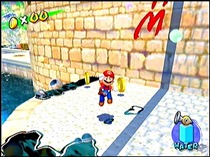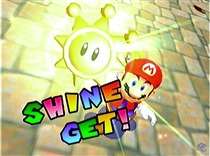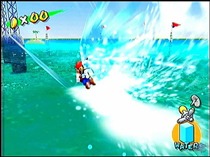We take a look back at the games worthy enough to be considered the GameCube's best.


Super Mario Sunshine
Released August 25, 2002
Developed by Nintendo
Published by Nintendo
NWR Reviews: 10 - 9.5 - 9.5 - 8.0
Retrospective by Jonathan Metts
For pure, visceral fun, there is no better GameCube title than Super Mario Sunshine. Nintendo made the controversial decision to let Luigi be the star of GameCube's launch, delaying Mario's debut on the system until nearly a year later. But action fans were rewarded for the wait, as Sunshine is easily one of the best 3D platformers ever released and most certainly the most hardcore Super Mario game yet. How surprising it was to find that Nintendo didn't coddle players with the company's most famous and influential series! Sunshine is undeniably difficult, a platforming game in which the focus is less on collecting bafmodads and more on perfectly timing complex jumping moves.
Part of the reason Sunshine can get away with applying old-school 2D difficulty to a modern 3D platformer is that the water pack's hover function helps reduce the inherent perspective problems of jumping in a 3D space. Meanwhile, the water hose function gives Mario a persistent weapon (other than his feet or rump) for the first time in the series. Nintendo probably hurt the game's sales potential with their misleading marketing campaign, which depicted cleaning as the game's theme. In reality, only a few missions out of several dozen total involve a lot of sludge-washing, and it can actually be a lot of fun in those small doses.
While Nintendo showed that the Mario gameplay can evolve with new mechanics like hovering and shooting, they also proved that they are still the masters of pure platforming level design with the beloved/dreaded "warp zone" levels. With his trusty water pack temporarily removed, Mario must race through devious obstacle courses using only his incredible jumping skills and the player's sense of timing. Like so many other gameplay elements in Sunshine, the warp zones are an evolution from Super Mario 64 – in this case, the extremely difficult Bowser levels. Sure, the warp zones may tease a few dirty words from your mouth, and they may even lead to a broken controller, but they are also tantalizing and addictive, and that incredible music doesn't hurt, either.
In contrast to the N64's legacy, GameCube was home to relatively few 3D platformers of any reasonable quality. That makes Super Mario Sunshine even more indispensable to any GameCube owner's library. History will likely treat Sunshine with the respect it deserves, as has been the case with the other black sheep of the Mario franchise, Super Mario Bros. 2 (USA).
Thoughts From the NWR Staff
Steven Rodriguez: "Mare Bay had the tall tower in the middle of the water, and I decided to scale it to its highest point. Once I got to the tip-top of the top tip, I looked out to sea and saw nothing but it. Then I looked straight down. I don't ever remember being that high above the ground in a videogame, still being able to see the ground below. Of course, the best part was how long it took for Mario to hit the water below after I commanded him to leap off from his little diving platform. I wanted to do it again, but it was a long climb back up... "
Daniel Bloodworth: "I've never been one to understand the hate Mario Sunshine received. Perhaps managing the backpack controls was a bit much for people. Perhaps the structure was too similar to Mario 64 with less variety and more collecting. Perhaps the commercials just made it too easy to hate on. Or perhaps the story did interfere. (I played the Japanese version so I wouldn't know.) In any case, I can't think of many games that have ever given me the same sense of pure joy to play. I climbed to the highest points, spun around power lines, skimmed the surface of the water, and simply had a blast the whole time. Like Steven, I also couldn't resist the Mare Bay high dive. I willingly took on the project of writing the Blue Coin Guide for NWR. And finally, no mention of Mario Sunshine would be complete without this picture."
David Trammell: "Super Mario Sunshine has it where it counts--gameplay. The only thing I didn't like about Super Mario Sunshine was its environments. Perhaps I was spoiled by the best platformers on the N64, but I wanted to see all the typical levels (with fresh gameplay of course) in GameCube glory. Although I quickly tired of the persistent island theme, I can't deny that it was used superbly given its limitations. In retrospect, I've yet to play more than a third of the American version, having played the Japanese version first (earning every shine to boot)."
Jonathan Metts: "For six years, Nintendo fans clamored for Super Mario 64 2. When they finally got it, many people just weren't satisfied. Sunshine is criticized equally for holding on to the past and for trying new things. For me, the only valid complaints are technical -- muddy textures in some locations, occasionally spastic camera. For pure, old school platforming, nothing on GameCube or its contemporary systems comes close to the accomplishments of Super Mario Sunshine."
Michael Cole: "Super Mario Sunshine captured the joy of jumping and climbing on structures. So while I agree it isn't 100% old-school platformer, it is close enough in my book."
Mike Sklens: "This is the reason I region-modded my GameCube. It gets flack for being cutesy, which is actually something a lot of GameCube games (and the system itself) get railed for. However, the platforming is amazing, especially in the purely platforming areas of the game. The challenge level there is high and the satisfaction earned is well worth it. Oh, and the water looks amazing."
A Dissenting Opinion
Evan Burchfield: "With all the secrecy around Super Mario Sunshine's premise leading up to its release, it was obvious Nintendo was very proud of their water backpack masterpiece. Years later Nintendo admitted that Super Mario Sunshine was more of a Mario side story than a part of the Mario canon. Why did they say this? For all its length and platforming and high-jumping antics, Sunshine didn't bring anything new to the table except a foreign setting and annoying cut scenes. Nintendo also hadn't learned that story is of the least consequence in Mario, yet they badgered us with dialog, a consistent world that bridged the gap between Mario abstraction and Zelda continuity (a gap that should widen), and levels filled with characters and objectives rather than action-platforming. Recalling the amount of coins I had to collect and stupid water-based puzzles I had to solve just spoiled the few action-oriented portions of the game, like the bonus levels. Those were successful, unlike the rest of the game which is a fun, frustrating step back for Mario."
Nintendo has considered releasing a second Mario platformer on GameCube at more than one point. First it was Mario 128, a chaotic tech demo shown at Spaceworld 2000 in which over a hundred tiny Mario characters ran and jumped all over a 3D sphere. Some of the mechanics of this demo are now seeing the light of day in Super Mario Galaxy for Wii. Super Paper Mario is another platformer that started on GameCube but is now headed to Wii. Of course, GameCube still saw plenty of Mario, thanks to numerous starring roles in the Mario Sports games (the talented plumber plays baseball, tennis, golf, soccer, and even basketball) as well as numerous cameos in other titles.







